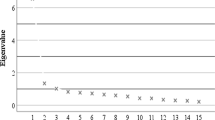Abstract
Green building development is an upcoming topic and is driven mostly by the growing awareness of the environment impact of construction on the satisfaction, health, performance, well-being and productivity of its occupants. Therefore, the purpose of this study is to identify the relationship between Indoor Environmental Quality (IEQ) and occupant’s satisfaction in a Platinum rated GBI’s office building located in the heart of Kuala Lumpur, Malaysia. Data were collected through self-administered questionnaire from the building occupants and analysed using Statistical Package of Social Science (SPSS) and Structural Equation Modelling (SEM) Smart PLS. This analysis was conducted in obtaining the level of reliability and validity of the data in measuring occupant’s productivity in relation with the IEQ. Subsequently, the result of the Variance Inflation Factor (VIF) for each of the variables shows that there are no collinearity issues in between the attributes.
Access this chapter
Tax calculation will be finalised at checkout
Purchases are for personal use only
Similar content being viewed by others
References
Barclay D, Higgins C, Thompson R (1995) The Partial Least Squares (PLS) approach to causal modelling: personal computer adoption and use as an illustration. Technol Study 2(2):285–309
Buildings GBI (2015) http://new.greenbuildingindex.org/
Building Occupants Survey System Australia (BOSSA) http://www.bossasystem.com/
Center for the Built Environment (CBE) Occupant indoor environmental quality (IEQ) Survey. https://www.cbe.berkeley.edu/research/survey.htm
Fornell C, Larcker DF (1981) Evaluating structural equation models with unobservable variables and measurement error. J Mark Res 18:39–50
Green Building Council of Australia (GBCA) (2009) Green star rating tool categories, GBCA.”<http://www.gbca.org.au/green-star/green-star-overview/green-star-rating-toolcategories/2141.htm>
Hair JF Jr, Money AH, Page M, Samouel P (2007) Research methods for business. Leyh Publishing, LLC
Hair JF, Hult GT, Ringle CM, Sarstedt M (2012) A primer on partial least squares structural equation modelling (PLS-SEM). 126–145
Hair JF, Hult GT, Ringle CM, Sarstedt M (2014) A primer on partial least squares structural equation modelling (PLS-SEM). 60–78
Henseler J, Ringle CM, Sinkovics RR (2009) The use of the partial least square path modeling in international marketing. In: New challenges to international marketing advances in international marketing, vol 20, pp 277–319
Hill, R. (1998). What sample size is enough in internet survey research? Interpersonal Computing and Technology: An Electronic Journal for the 21st Century, 6 (3–4)
Hulland J (1999) Use of partial least squares (PLS) in strategic management research: a review of four recent studies. Strateg Manag J 20(2):195–204
Isaac S, Michael WB (1995) Handbook in research and evaluation. Educational and Industrial Testing Services, San Diego, CA
Julious SA (2005) Sample size of 12 per group rule of thumb for pilot study. Pharmaceutical Statistics
Sekaran U, Bougie R (2013) Research methods for business: a skill- building approach. John Wiley & Sons Inc, New York
The Center for the Built Environment (CBE), Available at: http://cbe.berkeley.edu/
Van Belle G (2002) Statistical rules of thumb. John Wiley, New York
Author information
Authors and Affiliations
Corresponding author
Editor information
Editors and Affiliations
Rights and permissions
Copyright information
© 2018 Springer Nature Singapore Pte Ltd.
About this paper
Cite this paper
Tharim, A.H.A., Samad, M.H.A., Ismail, M. (2018). Relationship Between Indoor Environmental Quality (IEQ) and Occupant’s Satisfaction in Malaysian Rated Office Building: A Pilot Study. In: Yacob, N., Mohd Noor, N., Mohd Yunus, N., Lob Yussof, R., Zakaria, S. (eds) Regional Conference on Science, Technology and Social Sciences (RCSTSS 2016) . Springer, Singapore. https://doi.org/10.1007/978-981-13-0074-5_2
Download citation
DOI: https://doi.org/10.1007/978-981-13-0074-5_2
Published:
Publisher Name: Springer, Singapore
Print ISBN: 978-981-13-0073-8
Online ISBN: 978-981-13-0074-5
eBook Packages: Business and ManagementBusiness and Management (R0)




